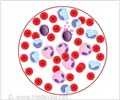- In Acute Myeloid Leukemia (AML) there are abnormal amounts of white blood cells in the body
- Therapy-related AML (t-AML) and AML with myelodysplasia-related changes (AML-MRC) are two high-risk types of AML with poor outcomes
- FDA has approved Vyxeos (a combination drug made up of Daunorubicin and Cytarabine) that may help patients with t-AML and AML-MRC live longer
Acute Myeloid Leukemia
In acute myeloid leukemia (AML) the bone marrow makes excess amounts of a type of white blood cell called myeloblasts. Although AML starts in the bone marrow it quickly progresses to the bloodstream and is hence termed “acute”. Other blood-forming cells can also become AML. Symptoms of AML include fever, fatigue and easy bleeding.Risk factors of acquiring AML have been listed as being male, smoking, previous chemotherapy or radiation therapy, prior treatment for childhood acute lymphoblastic leukemia (ALL), exposure to radiation from an atomic bomb and having certain blood disorders. AML can sometimes spread to other parts of the body.
There are different subtypes of AML. This study is concerned with two types of high-risk AML, namely, newly diagnosed therapy-related AML (t-AML) and AML with myelodysplasia-related changes (AML-MRC).
T-AML is cancer that results due to prior exposure to chemotherapy or radiation (mostly given for breast and colon cancers) that occurs within an average of five years after start of treatment, in approximately 8 to10 percent of all treated patients. When patients have AML-MRC they are faced with a history of certain blood disorders and other significant mutations within cancer cells. Patients with either of the conditions have very low life expectancies.
There are four types of standard treatment methods used for AML: Chemotherapy (including Daunorubicin and Cytarabine), Radiation therapy, Stem cell transplant and anticancer drug therapy that includes arsenic trioxide and all-trans retinoic acid (ATRA).
The outcome of patients with AML depends on patient and disease characteristics and the therapy method.
Study
The safety and efficacy of Vyxeos were tested in a randomized study in which patients received either Vyxeos or separately administered treatments of Daunorubicin and Cytarabine. There were 309 patients in total in the study who had been diagnosed with t-AML or AML-MRC for the first time. The trial measured the overall survival of the patients (how long patients lived from the date they started the trial).The end results showed that patients who received Vyxeos lived longer (median overall survival 9.56 months) than patients who received separate treatments of Daunorubicin and Cytarabine (median overall survival 5.95 months).
Contraindications while using Vyxeos
Although beneficial Vyxeos has its share of side effects that include serious or fatal bleeding events, fever with low white blood cell count, rashes, edema, nausea, diarrhea, constipation, muscle and joint pain, fatigue, chills, abdominal pain, difficulty in breathing, headache, cough, decreased appetite, arrhythmia, pneumonia, and blood infections.Patients who are prone to be sensitive to Daunorubicin or Cytarabine have been advised not to use Vyxeos.
Also, patients taking Vyxeos should be closely monitored for hypersensitivity reactions and decreased cardiac function.
Patients taking Vyxeos are also warned against interchanging the drug with other Daunorubicin- and/or Cytarabine-containing products.
Vyxeos should not be taken by pregnant or breastfeeding women because it could harm a developing fetus or a newborn baby.
Combinations in general usually work better than single drugs in chemotherapy as they comprise of different drugs that work in different ways. Also, since t-AML and AML-ARC are very high-risk types of acute myeloid leukemias that could be fatal, the move that FDA has made in approving the combination drug Vyxeos to be administered for patients suffering from these conditions will benefit them by prolonging their lives.
References:
- FDA approves first treatment for certain types of poor-prognosis acute myeloid leukemia - (https://www.fda.gov/NewsEvents/Newsroom/PressAnnouncements/ucm569883.htm)
- What Is Acute Myeloid Leukemia? - (https://www.cancer.org/cancer/acute-myeloid-leukemia/about/what-is-aml.html)
- Adult Acute Myeloid Leukemia Treatment (PDQ®)–Patient Version - (https://www.cancer.gov/types/leukemia/patient/adult-aml-treatment-pdq)
Source-Medindia












